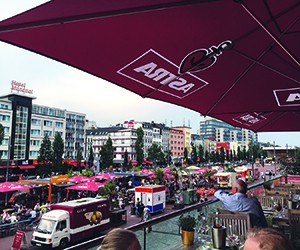Moin moin! I quickly became accustomed to this common Hamburg greeting while on the German Convention Bureau’s Hamburg Education Trip, designed to connect meeting planners with the city’s offerings, both new and old.
Despite being Germany’s second-largest city and a major port for northern Europe, Hamburg doesn’t get the international recognition less-populated cities such as Munich, Frankfurt, Cologne and Stuttgart receive. But that might be changing due to numerous projects that are mixing modern functionality and forward thinking in this historic city that rose to economic prominence in the late 19th century due to trade and industrialization surrounding the port.
At the top of the list is the long-awaited debut of the Elbphilharmonie, scheduled to open in early January just in time for the 2017 symphony season. The concert hall is newly built atop an old warehouse building on the bank of the Elbe River and features curved glass panels designed to imitate the crest of a wave. The heart of the philharmonic hall is the 2,100-seat Grand Concert Hall, but there are two additional concert halls, a music education area, food and beverage outlets as well as a public plaza. Sharing the newly constructed building is The Westin Hamburg. I was lucky to be among the first to step foot in the 244-room hotel prior to its opening in early November. Our hard hat tour included getting a sneak peek at the guest rooms, bar and restaurant, indoor pool and 5,000 square feet of meeting space.
We also had the opportunity to see the Elbphilharmonie from the Elbe River aboard the MS Jacob, the Hotel Louis C. Jacob’s private boat, which transported us up the river to the hotel for dinner. On what we were told was one of the warmest evenings of the year, we took in the city views from the water and expansive homes that line the banks of the river. Once at the Hotel Louis C. Jacob, our group climbed down into the hotel’s wine cellar for the first course of the evening’s progressive dinner from resident Michelin-starred chef Thomas Martin. We then moved into the kitchen to get an up close, behind-the scenes glimpse at how the team works together, before settling in the dining room at Jacob’s Restaurant and ending the balmy night on the Lime Tree Terrace.
The Elbphilharmonie and Westin are located in the HafenCity neighborhood, one of Europe’s largest sustainable urban development projects. We spent a morning on a walking tour of the area that was once filled with old port warehouses that are now in the midst of being replaced by residential and office buildings, hotels, shops, schools and markets, and plenty of green park space.
The HafenCity is adjacent to the historic warehouse district known as Speicherstadt, a UNESCO World Heritage Site that has kept its historic charm and look while offering modern, renovated spaces and group activities. We got a taste—literally—of the Speicherstadt with a tour of Spicy`s Gewürzmuseum, where I learned that gewurz means “spice” (where spicy gewurztraminer wine gets its name), in addition to the role the Hamburg port played in the Far East spice trade. Coffee was also an important trade commodity, and we were treated to a private tasting and seminar on roasting coffee beans and the different styles of brewing.
Mixed in with the new development in Hamburg is the charm of its rivers and canals. The city has more bridges than Venice, parks make up 15 percent of the municipal district, and stately homes, church steeples and grand hotels abound. We stayed at the Le Meridien Hamburg, situated in the trendy St. Georg neighborhood. The 275-room hotel offers 13 meeting rooms, most of which overlook Outer Alster Lake, along with Heritage Restaurant and Bar, perched on the top floor of the hotel with what has to be one of the best views in Hamburg.
Alster Lake, divided into two by a dam, is a manmade lake formed by the Alster River, creating a public space for sailing, paddleboarding, canoeing and steam boating, as we did on the historic St. Georg. While cruising the lake and connected canals, our group got competitive with gamification organized by local company Geo Bound.
Just down the road is the Hotel Atlantic Kempinski, which first opened in 1909 and often accommodated Europe’s upper-class before they boarded ships for cross-Atlantic voyages. Today, the property offers 221 guest rooms, 13 opulent meeting rooms and a courtyard atrium.
About a 10-minute walk, or five-minute bicycle ride (a popular mode of transportation in the city), across from Inner Alster Lake and near Hamburg Rathaus, or City Hall, is The Fairmont Hotel Vier Jahreszeiten. While touring the 156-room property the attention to detail did not go unnoticed, from its luxurious suites and the two-Michelin starred Haerlin Restaurant to the meeting and function rooms. Another option for groups that want the same five-star experience, but need more space, is the Grand Elysee Hotel Hamburg. The 551-room hotel is near the Congress Center Hamburg and offers over 45,200 square feet of meeting space across 30 rooms.
A trip to Hamburg wouldn’t be complete without a visit to the Reeperbahn Street, home to the city’s Red Light District, which today is lined with restaurants, bars and clubs filled with tourists and party-goers. Our G-rated night out included checking out east Hotel Hamburg, a 128-room design-forward property within walking distance to infamous street, a walking history tour of the district and dinner on a terrace giving us a bird’s-eye view of the rowdy scene.




